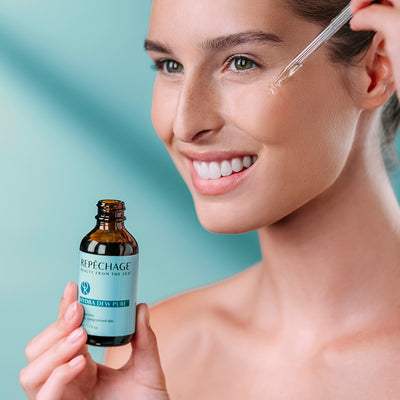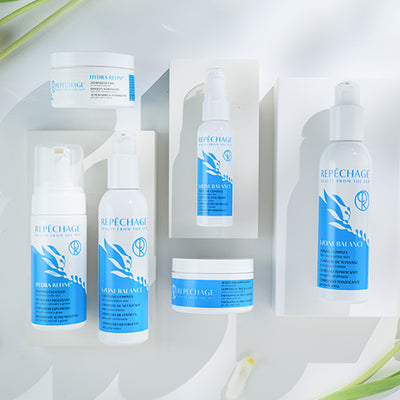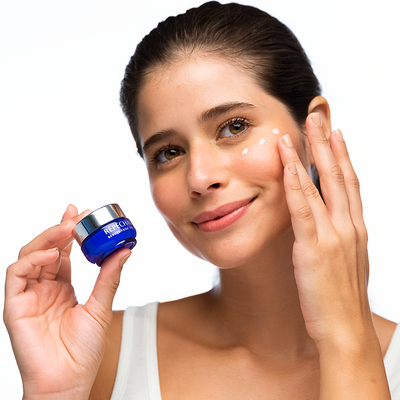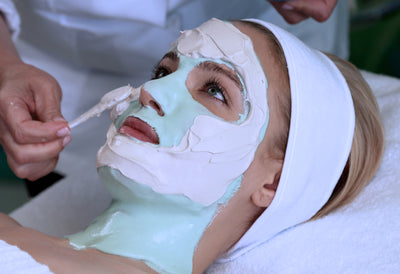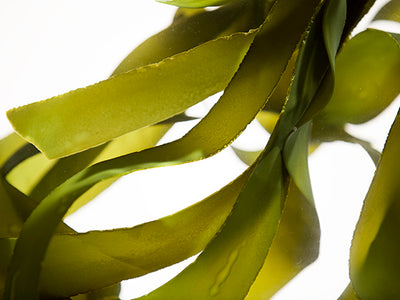Sustainable Seaweed In Skin Care by Lydia Sarfati
Walk along the beach and you will probably find a treasure washed up from the ocean, although you may not know it. Seaweed may seem like the dandelions of the sea, but the multitude of benefits of these humble sea plants are the subject of serious research, and is one of the top subjects in international communities for development.
Leading scientists are looking towards seaweed and aquaculture to find numerous applications in the modern world because of their composition and ability to grow just about anywhere in the ocean.
“Seaweeds are abundant and ancient autotrophic organisms that can be found in virtually all near-shore aquatic ecosystems. They form an important living resource of the near shore environment. For millennia, people have collected seaweeds for food, fodder for animals and well as fertilizers and soil enhancers. More recently, seaweeds have become important sources of various bioreactive molecules, and are important in medicine and biotechnology. Containing phycocolloids, or polysaccharides, they are also used in toothpaste, soaps, shampoos, cosmetics, skin care, milk, ice cream and many other items.”1
 C-Serum Seaweed Filtrate
C-Serum Seaweed Filtrate
The first form of life was derived from unicellular marine microalgae, which appeared in the ocean over 3.5 billion years ago. There are over 40,000 different species of marine micro-and macroalgae worldwide. The oldest of the marine macroalgae with fossils being found at are at least 1.2 billion years old. Scientists believe that marine algae may produce over 60% of the earth’s oxygen. Researchers point out the almost uncanny similarity between seawater and human plasma, our intercellular fluid. The sea covers over two-thirds of our planet, and, perhaps as no coincidence, the human body is made of two-thirds water as well. Seaweed is a very powerful concentration of seawater. One liter of seaweed contains the same concentration of elements found in 10,000 liters of seawater. Seaweeds have no roots, stems or leaves but rather have parallel structures including holdfasts, stipes and blades, respectively. They are able to uptake minerals by absorption and active transport from seawater and have close symbiotic associations with bacteria for important vitamins necessary for their growth. Because of these processes, some seaweeds become a dense concentration of vitamins, minerals, trace-elements, macro-elements, phytohormones, amino acids, proteins and lipids.
According to the Food and Agriculture Organization, seaweed use has increased 176% since 1995, and predictions have an even greater growth in the future. The benefits of seaweed for health and well-being has been studied for many years, but there is a renewed interest in seaweed as a sustainable and plentiful source of many important ingredients to help treat many pathologies, including the most complex of organs, the brain. According to an article in the Journal of Applied Phycology, “Seaweeds produced under controlled conditions offer boundless opportunities to satisfy the known requirements for brain health and could readily play important roles in improving overall human health and well-being.”2


Seaweed and Skin Care:
For centuries, people have turned to the sea for its renewing properties. Thalassotherapy, stemming from the Greek word for sea, “thalassos”, is a term coined to describe the usage of seawater for therapeutic purposes and preventative measures based on the belief that immersion in seawater helps promote wellbeing and cleanses the system. Bathing in seawater is one of the deepest rooted bathing traditions. Today, the tradition of thalassotherapy continues as spas and skin care centers around the world.
In skin care, specific seaweeds can be used to create a number of beneficial cosmetic effects including decreasing the appearance of oil, diminishing the appearance of fine lines and wrinkles, exfoliating the skin for a more luminous looking complexion and moisturizing the skin to make it feel and look soft and smooth.
Seaweed needs light for photosynthesis, which converts light energy into chemical energy producing sugars and oxygen. The colors of seaweeds are determined by the photosynthetic pigments including chlorophylls, phycobiliproteins, xanthophylls and carotenoids. Seaweeds also have compounds such as mycosporine-like amino acids that protect them from ultraviolet light too.
Here is a list of some of these key species used in skin care today:
Laminaria Digitata
A brown seaweed found in the very low intertidal and shallow subtidal marine environments in the Atlantic and Pacific Oceans. This seaweed is often called the horsetail kelp and is a natural source of 12 vitamins including B12, C, E, K and beta carotene, 18 amino acids, and as many as 42 trace elements. Laminaria digitata is renowned for its ability to help moisturize the skin.
Codium Fragile Subsp. Atlanticum
A green seaweed anchored to rocks from 1 cm to a few many meters in size found in the intertidal to shallow subtidal marine environments with branched cylindrical fronds. Known to help instantly boost moisture.
Ascophyllum Nodosum
A brown seaweed, which thrives in the upper intertidal and shallow subtidal marine environments in the North Atlantic Ocean. It is often called knotted wrack or rockweed. It is rich in vitamins, minerals, and amino acid, phytohormones, fucoidan and alginic acid. Helps skin look smooth and soft.
Ulva Compressa
Green sheets or tubular in construction found in many near shore environments around the globe. This helps skin look and feel firmer.
Ahnfeltia Plicata (formerly referred to as “Ahnfeltia concinna”)
A wiry subtidal red marine alga from the coast of the Hawaiian Islands and now found along the coasts of the north Atlantic Ocean often associated with the holdfasts of kelp. Helps to restore moisture and soothe the skin.
Ulva Lactuca
A green seaweed found in the intertidal and shallow subtidal marine environments all over the world. This helps reduce the visible signs of aging, diminishing the appearance of fine lines.
Saccharina Latissima
This brown seaweed is known as the sugar kelp. It is found in the shallow subtidal cold water environments in the Atlantic and Pacific Oceans. It too is rich in many vitamins, minerals, trace elements, amino acids, and alginic acid. This helps reduce the appearance of oil on the skin.
Fucus Vesiculosus
This brown macroalga is often called rockweed. It is found in the intertidal to shallow subtidal marine environments of the North Atlantic Ocean. It is rich in vitamins, contains fucoidan, and alginic acidic. This seaweed helps with deep cleansing and reducing the appearance of oil.
Porphyridium spp.
A group of single celled red microalgae that is high in essential fatty acids as well as Vitamins B and C. Helps with oily skin.
Lithothamnion Calcareum
A red alga whose main feature is the formation of calcium carbonate in its cell walls. Helps skin look and feel firmer, more toned.
Pelvetia Canaliculata
A brown alga found attached to rocks of the upper intertidal rocky shores in the eastern Atlantic Ocean. Helps reduce the appearance of dark spots.
Quality Control and Sustainability:
While Asia is the largest market of seaweed globally and accounted for more than 55% of market share in 2015, North America is the fastest growing region for seaweed applications and market growth. Recent reports have found that the seaweed industry is undergoing a rapid global expansion and currently accounts for approx. 49% of the total mariculture production, with the industry valued in total $6.4 billion in 2014.3 Of key importance is biosecurity, disease prevention and detection, and creating sustainable, healthy environment for seaweed that will create a sustainable balance between economic growth and ocean health.
Water quality is key to seaweed sustenance and growth. As seaweed absorbs the seawater around it, the environment in which the seaweed is grown is of paramount importance to the health of these marine plants. It is important to source seaweed from the most pristine environments, such as off the coast of Down East Maine. Traditionally seaweeds were collected from natural stocks or wild populations. However, these resources were being depleted by overharvesting, so cultivation techniques are being developed. Today, seaweed can be wild harvested, or grown through aquaculture (farming). Depending on the situation, some are hand harvested and at other times mechanically harvested. For wild harvesting, the harvest takes place early in the morning, during the lowest tides of the spring and summer months that accompany the new and full moons.


Small boats travel to the kelp beds on exposed ledges to harvest, working at the lowest point of the low tide line into the subtidal where the seaweeds cling to the rocks. The work is difficult, in that the harvester has to carefully cut the seaweed as the plants are briefly exposed between the swells of the waves. The cutting has to done with specific techniques to allow for sustainable growth and ensure the long-term health of the seaweed plants and minimal impact on the local ecosystem. Once brought back to shore, the seaweed is immediately hung to dry away from direct sunlight, reaching a shelf stable condition within 24-36 hours, at which point it may be stored for up to a year under proper conditions.
Seaweed can be specifically grown on ropes (or longlines) suspended in seawater , harvested by boat along floating lines and gathered into nets or large storage bins on harvesting boats. Crops are harvested over a period of a month or two until temperature conditions limit the growth of the crop. For industrial use, the seaweed is initially stored in wet chambers then dried at temperatures that minimize degradation of bioreactive compounds.4
With the increased interest and research into seaweed, this natural ingredient, already used in many skin care products, promises to become an even more important ingredient for wide spread use, from medicine to even biofuels. Proper regulation and maintenance of sustainable harvesting procedures will be paramount to assure that the seaweed has a broad genetic diversity and of the same quality. Likewise, environmental regulations of water quality will be important to provide a suitable environment for seaweed growth. Once in place, seaweed offers an extremely promising future as a staple ingredient.
1 Pereira, R. and C. Yarish. 2008. Mass production of Marine Macroalgae. In Sven Erik Jørgensen and Brian D. Fath (Editor-in-Chief), Ecological Engineering. Vol. [3] of Encyclopedia of Ecology, 5 vols. pp. 2236-2247. Oxford: Elsevier.
2 Cornish, M.L., A.T. Critchley & O.G. Mouritsen .January, 2017. Consumption of Seaweeds and the Human Brain, Journal of Applied Phycology. DOI 10.1007/s10811-016-1049-3
3 Cottier-Cook, E.J., Nagabhatla, N., Badis, Y., Campbell, M., Chopin, T, Dai, W, Fang, J., He, P, Hewitt, C, Kim, G. H., Huo, Y, Jiang, Z, Kema, G, Li, X, Liu, F, Liu, H, Liu, Y, Lu, Q, Luo, Q, Mao, Y, Msuya, F. E, Rebours, C, Shen, H., Stentiford, G. D., Yarish, C, Wu, H, Yang, X, Zhang, J, Zhou, Y, Gachon, C. M. M. (2016). Safeguarding the future of the global seaweed aquaculture industry. United Nations University (INWEH) and Scottish Association for Marine Science Policy Brief. ISBN 978-92-808-6080-1. 12pp
4 Cottier-Cook, E.J., Nagabhatla, N., Badis, Y., Campbell, M., Chopin, T, Dai, W, Fang, J., He, P, Hewitt, C, Kim, G. H., Huo, Y, Jiang, Z, Kema, G, Li, X, Liu, F, Liu, H, Liu, Y, Lu, Q, Luo, Q, Mao, Y, Msuya, F. E, Rebours, C, Shen, H., Stentiford, G. D., Yarish, C, Wu, H, Yang, X, Zhang, J, Zhou, Y, Gachon, C. M. M. (2016). Safeguarding the future of the global seaweed aquaculture industry. United Nations University (INWEH) and Scottish Association for Marine Science Policy Brief.



